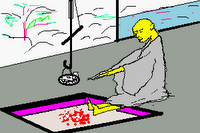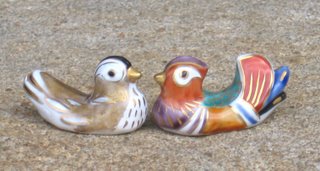:::::::::::::::::::::::::::::::::::::::::::::::::::::::::::::::::::::::::::::::::::::::::::::::::::::
Daruma Stove
だるまストーブ Daruma sutoobu
They are used at home and in the special trains of Northern Japan and Hokkaido.

Photo from my friend Ishino.
Click HERE for more photos !
External LINK
Daruma stove in a train, Fuyu no Shitsugen-go (Winter Bog)
:::::::::::::::::::::::::::::::::::::::::::::::::::::::::::::::::::::::::::::::::::::::::::::::::::::
H A I K U
kigo for all winter
danro 暖炉 (だんろ) fireplace, heating
..... danro 煖炉(だんろ)
hekiro 壁炉(へきろ) fireplace in the wall
Kotatsu 炬燵, a heated table
and its appliances
stove ストーブ sutoobu (stoobu)
wood stove, makisutoobu 薪ストーブ
coal stove, sekitan sutoobu 石炭ストーブ
oil heater, sekiyu sutoobu 石油ストーブ
steam heater, suchiimu hiitaaスチームヒータ-
electric stove, denki sutoobu 電気ストーブ
gas heater, gasu sutoobu ガスストーブ
ondoru 温突 (オンドル) Korean-style floor heating
. . . CLICK here for Photos !
danboosha 暖房車(だんぼうしゃ)train compartment with a heating stove
. . . CLICK here for Photos !
..... sutoobu ressha ストーブ列車
fireplace, danboo 暖房 / 煖房
ro 炉 (ろ) fireplace, sunken hearth
fire in the hearth, robi 炉火
light from the hearth, ro akari 炉明
smalltalk by the hearth, robanashi 炉話(ろばなし)
. irori 囲炉裏 いろり open sunken hearth .
- Introduction -
..... uzumibi 埋火, うずみび

Ryokan warming himself at a small fire (uzumibi)
埋火(うずみび)
black coals, kurozumi 黒墨
white coals, shirozumi 白墨
mokutan 木炭(もくたん)charcoal and related KIGO
hota 榾 (ほた) firewood, firewood fire
..... hoda ほだ
nehoda 根榾(ねほだ)roots as firewood
hotabi 榾火(ほたび)fire from firewood
hota akari 榾明(ほたあかり)breaking the firewood
Usually branches are broken over the knee.
hoda no yado 榾の宿(ほだのやど)home with firewood fire
hoda no nushi 榾の主(ほだのぬし)caretaker of the firewood fire
In old farmhouses, hoda firewood from dried cut tree trunks, branches and roots is used for the open fireplace. Its fire provides light for the family to eat and keep warm. hoda is a beloved traditional kigo.
hifukidake 火吹竹 (ひふきだけ) bamboo pipe to blow on the coals
. . . CLICK here for Photos !
jotan 助炭 (じょたん) cover to keep the coals warm
often used for the tea ceremony.
They are made from a wooden frame and covered with washi paper. They help to keep a room warm for a longer time.
. . . CLICK here for Photos !
hibachi 火鉢 brazier
teaburi, te aburi 手あぶり hand warmer
Cat Warmer, neko hibachi 猫火鉢
..... hioke, hi-oke 火桶(ひおけ)"fire box"
kiri hioke 桐火桶(きりひおけ)hibachi from paulownia wood
..... kiri hibachi 桐火鉢(きりひばち)
. . . CLICK here for Photos !
hako hibachi 箱火鉢(はこひばち)hibachi in box format
nagahibachi 長火鉢(ながひばち)long square hibachi
anka 行火 (あんか) old-type charcoal heater (to put under a kotatsu table to heat it)
. . . CLICK here for anka Photos !
..... neko hibachi ねこ火鉢(ねこひばち)
denki anka 電気行火(でんきあんか)electric heating device (for a kotatsu table)
shuro 手炉(しゅろ)handwarmer
. . . CLICK here for hand warmer Photos !
ashi aburi 足焙(あしあぶり)feet warmer, foot warmer, footwarmer
..... ashi nukume 足温め (あしぬくめ)
..... ashiro 足炉(あしろ), soku onki 足温器(そくおんき)
.................................................................................
observance kigo for mid-winter
yotsugi hota 世継榾 (よつぎほた) "successor firewood"
On the last day of the year (oomisoka), logs were put in the home fire of the open hearth (irori) to pass over into the new year, with the prayer that the family line would last as long as a never-ending fire in the heath.
turning my back
to the wood fire...
Saimyo Temple
hota no hi ni senaka muke keri Saimyooji
ほたの火にせなか向けり最明寺
by Issa, 1819
Tr. David Lanoue
. WKD : Temple Saimyo-Ji 最明寺
:::::::::::::::::::::::::::::::::::::::::::::::::::::::::::::::::::::::::::::::::::::::::::::::::::::
observance kigo for mid-winter
ohotaki, o ho taki 御火焚 (おほたき) "making a bonfire"
..... ohotaki 御火焼(おほたき)
ohitaki, o hi taki おひたき
oshitake, o shi take おしたけ : this is the pronounciation of the event in Kyoto.
In many temples and shrines and workplaces or restaurants that use fire, this custom is observed in the middle of the 11th lunar month. It used to mark the end of autumn and beginning of the winter season, with prayers to protect the region from fires.
The logs are placed in a square like the Chinese character for "well" 井, in the middle a bamboo offering (imidake いみだけ【斎竹/忌(み)竹】is placed.
Around the fire, food offerings and sake are placed.
Then a priest starts the fire, reciting prayers to protect the property from fire disaster.
The sweets and fruits offered to the deities are later distributed to the attending children. Fruit can also be roasted in the embers.

Nowadays, the official ceremonies are held
at Yasaka shrine 八坂神社 on the first,
at Fushimi Inari shrine 伏見稲荷大社 on the 8th, (including all craftsmen using fire, like blacksmiths and knife or sword makers)
at Niitama Tsushima shrine 新玉津島神社 on the 13th,
at Kitano Tanmangu shrine 北野天満宮 on the 25th
at temples dedicated to Fudo Myo-O the craftsmen of indigo dyeing, public baths owners, yunoshiya 湯熨斗屋 who make belts and other cloth, the fire ceremony is on the 28, the day dedicated to Fudo Myo-O.
御火焚や霜うつくしき京の町
ohitaki ya shimo utsukushiki kyoo no machi
bonfire ceremony -
the frost is so beautiful
in the town of Kyoto
. Yosa Buson 与謝蕪村
. Fire (kaji) and kigo
.................................................................................
observance kigo for the New Year
mikamaki 御薪 Honorable fire wood
..... mimaki 御薪(みまき)
mikamaki tatematsuru 御薪奉る(みかまぎたてまつる)
. First Court Rituals .
:::::::::::::::::::::::::::::::::::::::::::::::::::::::::::::::::::::::::::::::::::::::::::::::::::::
. Stove and heating the home in all seasons
KIGO LIST
:::::::::::::::::::::::::::::::::::::::::::::::::::::::::::::::::::::::::::::::::::::::::::::::::::::
- - - - - Kobayashi Issa - - - - -
翁さびうしろをあぶるほた火哉
okinasabi ushiro o aburu hotabi kana
an old man's ways--
my backside warmed
by the wood fire
Tr. David Lanoue
- - - - -
すぎはひやほた一ッ掘に小一日
sugiwai ya hota hitotsu horu ni ko-ichinichi
loggers dig up
a whole tree for firewood --
takes almost a day
Tr. Chris Drake
This winter hokku is from the New Year's album published in Kyushu by Issa in 1793, when he was 30, so the hokku was probably written while Issa was traveling around in various areas in western Japan. Issa seems amazed at the stamina and strong work ethic of the loggers, professional firewood providers who probably live in a forested area just below a mountain or perhaps on its lower slopes. These mountain men uproot trees every day and probably carry most of the cut logs down to farming villages and perhaps a local town, where people need firewood for their ovens and for the sunken hearth fires in the middle of the main room of many farmhouses. Hand- and footwarmers generally used charcoal.
The loggers dig up whole trees and use every part for firewood of different sizes. Some of the best wood comes from tree roots. Properly dried out, tree roots can burn for several days and were one of the most prized forms of firewood. Issa seems amazed at all the work that goes into uprooting even a single tree and thankful for the skill of the men who do it. For ordinary people, the job would no doubt take much longer.
Chris Drake
. Kobayashi Issa 小林一茶 in Edo .
:::::::::::::::::::::::::::::::::::::::::::::::::::::::::::::::::::::::::::::::::::::::::::::::::::::
pechika ペチカ Russian stove, pechka
. . . CLICK here for Photos !
滅びゆく階級きみのペチカ燃ゆ
horobiyuku kaikyuu kimi no pechika moyu
this social class is dying out -
your pechka is still burning
Yagi Hironobu 八木博信
:::::::::::::::::::::::::::::::::::::::::::::::::::::::::::::::::::::::::::::::::::::::::::::::::::::
五つ六つ茶の子にならぶ囲炉裏哉
itsutsu mutsu cha no ko ni narabu irori kana
Irori and tea cakes with
. Matsuo Basho 松尾芭蕉 - Archives of the WKD .
. Hearth for cooking (kamado 竈)
[ . BACK to WORLDKIGO . TOP . ]
[ . BACK to DARUMA MUSEUM TOP . ]
:::::::::::::::::::::::::::::::::::::::::::::::::::::::::::::::::::::::::::::::::::::::::::::::::::::








2 comments:
irori 囲炉裏 いろり open sunken hearth
jizaikagi 自在鈎 pothook
- part of the entry about
. Interior Design - The Japanese Home .
.
Kobayashi Issa
firewood cutters --
they spend almost a day
uprooting one tree
sugiwai ya hota hitotsu horu ni ko-ichinichi
すぎはひやほた一ッ掘に小一日
This winter hokku is from the New Year's collection published in Kyushu by Issa in 1793, when he was 30, so the hokku was probably written while he was traveling around in various areas in western Japan. Issa seems impressed by the stamina and strong work ethic of the loggers, professional firewood suppliers who probably live in a forested area at the foot of a mountain or perhaps on its lower slopes.
These mountain men cut and uproot trees every day and probably carry most of the logs and firewood down to farming villages and perhaps a local town, where people need firewood for their ovens and for the sunken hearth fires in the middle of the main room of many farmhouses. (Hand warmers and foot warmers, however, generally used charcoal, not sticks of firewood.) The loggers uproot whole trees and use every part from limb tips to roots for firewood of many different sizes. Properly dried out, tree roots can burn for several days and were one of the most prized forms of firewood. Issa seems amazed at the skill of the men and how much hard work it takes to uproot a large tree from the cold earth while carefully preserving as much as possible of the tree's main roots. For ordinary people, the job would probably be impossible or at least take much longer to do.
Chris Drake
.
Post a Comment